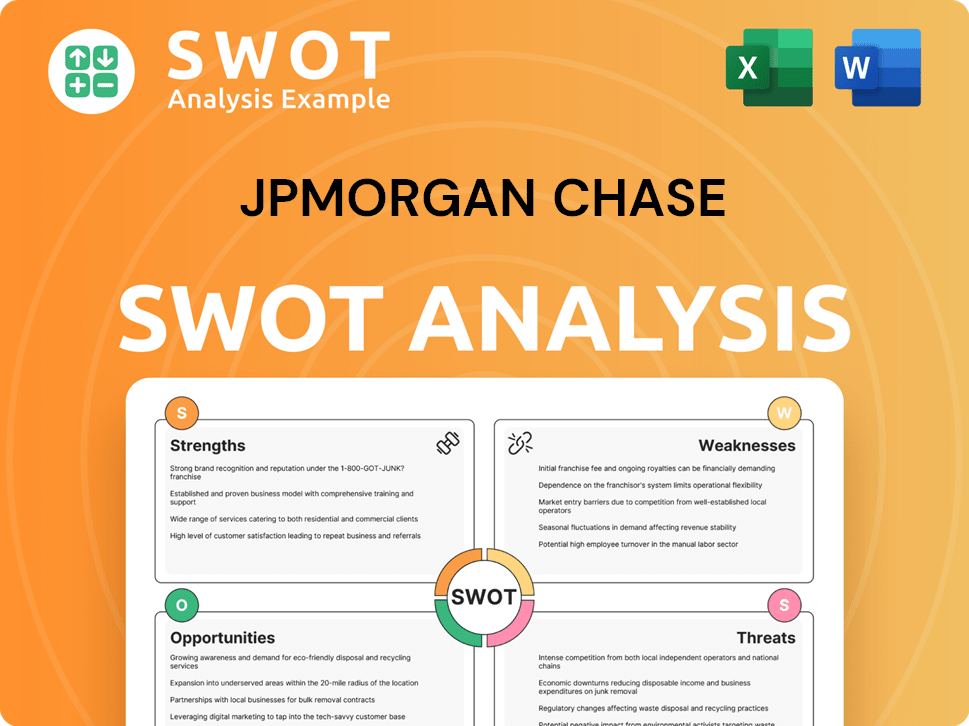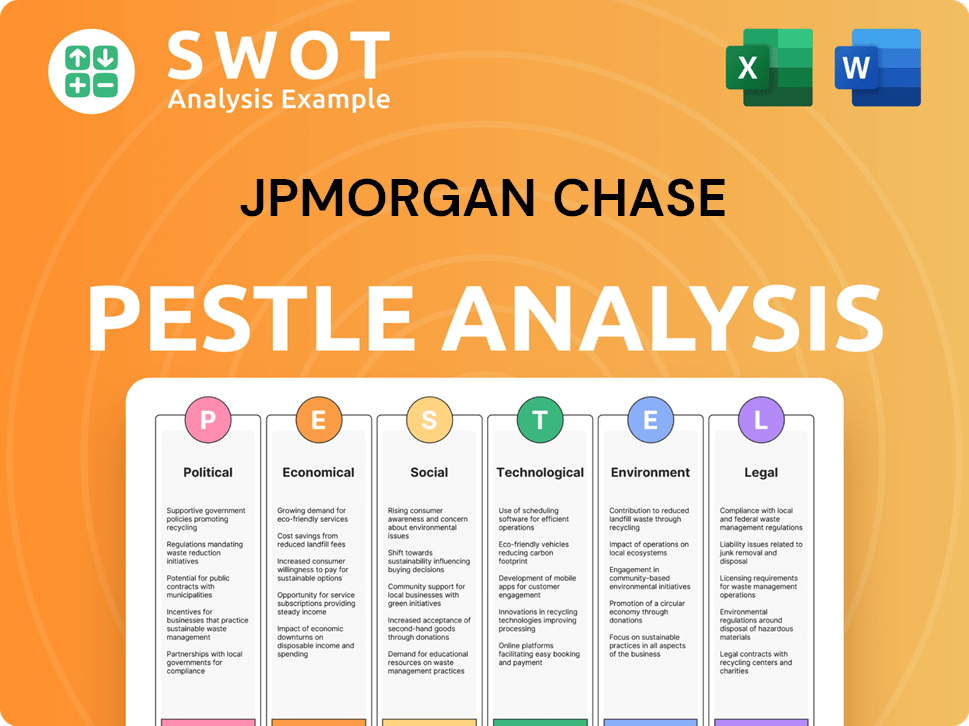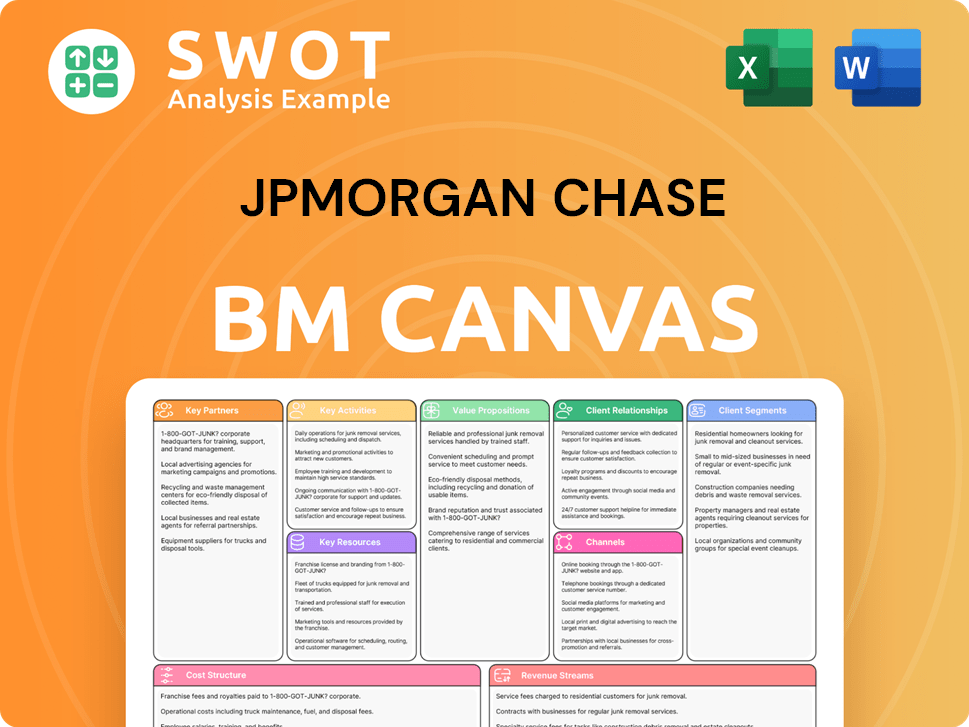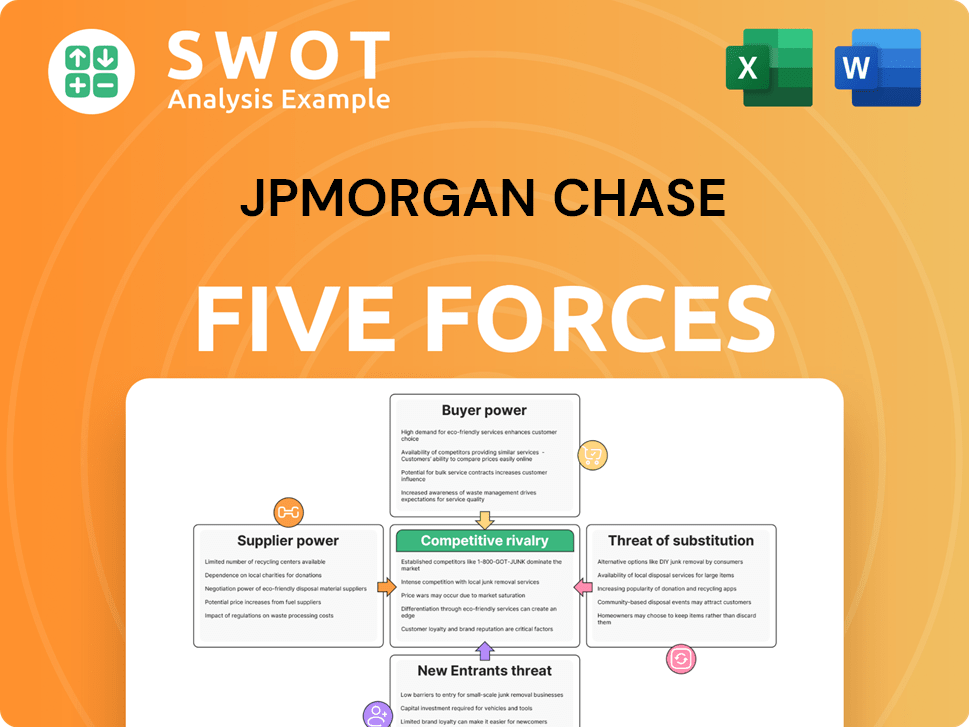JPMorgan Chase Bundle
Decoding the Juggernaut: How Does JPMorgan Chase Work?
JPMorgan Chase, a cornerstone of the global financial system, boasts an impressive track record, reaching record-breaking revenues in 2024. With a staggering $4.36 trillion in assets, this financial powerhouse isn't just big; it's systemically important. But how does this banking giant, encompassing both JPMorgan Chase SWOT Analysis and Chase Bank, actually function and generate its immense profits?

Understanding JPMorgan Chase's operations is key for anyone interested in financial services, from individual investors pondering "Is JPMorgan Chase a good investment?" to aspiring professionals exploring JPMorgan Chase careers. This exploration will unveil the firm's diverse revenue streams, spanning investment banking and commercial banking, and how it navigates the complexities of the market. We'll dissect its financial performance, offering insights into its enduring success and strategic foresight, providing a comprehensive understanding of this financial titan.
What Are the Key Operations Driving JPMorgan Chase’s Success?
JPMorgan Chase, a leading financial services firm, generates value through a diverse range of products and services. It serves a wide customer base, including individual consumers, corporations, governments, and institutions. The company's core operations are structured around three main segments: Consumer & Community Banking (CCB), Commercial & Investment Bank (CIB), and Asset & Wealth Management (AWM).
The company's value proposition centers on offering a comprehensive suite of financial solutions. This includes everything from everyday banking services to complex investment banking and wealth management strategies. JPMorgan Chase differentiates itself through integrated channels, robust risk management, and a strong focus on customer satisfaction, ensuring convenience and expert advice for its clients.
JPMorgan Chase's operational processes are significantly enhanced by technological advancements. The company invests heavily in technology, including AI and blockchain, to improve customer experience and operational efficiency. With a technology budget of approximately $12 billion in 2024, JPMorgan Chase is committed to innovation and leveraging its extensive distribution networks to serve millions of customers globally.
CCB provides a range of services including checking and savings accounts, credit cards, mortgages, and auto loans. This segment focuses on retail banking and serves individual consumers and small businesses. This segment is crucial for providing essential banking services and building customer relationships.
CIB offers investment banking services, sales and trading, prime brokerage, and treasury services. It is the world's largest investment bank by revenue. This segment caters to corporations, governments, and institutional clients, providing complex financial solutions and advisory services.
AWM provides investment management, wealth management, and private banking services. Assets under management reached $4.045 trillion in 2024. This segment focuses on managing investments and providing financial advice to high-net-worth individuals and institutional clients.
The company heavily invests in technology, with a budget of $12 billion in 2024, including AI and blockchain. JPMorgan Chase leverages its vast distribution networks to ensure widespread accessibility. This allows the company to serve millions of customers globally.
JPMorgan Chase offers a complete value proposition by combining banking, lending, and investing through integrated channels. This approach provides convenience, expert advice, and premium service to customers. The focus on risk management and customer satisfaction is a key differentiator.
- Integrated Financial Services: Offering a full suite of financial products.
- Customer-Centric Approach: Prioritizing customer satisfaction and expert advice.
- Technological Innovation: Investing heavily in technology to enhance services.
- Global Reach: Serving millions of customers worldwide through extensive distribution networks.
JPMorgan Chase SWOT Analysis
- Complete SWOT Breakdown
- Fully Customizable
- Editable in Excel & Word
- Professional Formatting
- Investor-Ready Format

How Does JPMorgan Chase Make Money?
JPMorgan Chase, a leading financial institution, generates substantial revenue through diverse streams, reflecting its extensive financial services offerings. The company's robust financial performance in 2024 underscores its effective monetization strategies and strong market position. Understanding these revenue streams and how they are monetized is crucial for investors and stakeholders.
In fiscal year 2024, JPMorgan Chase reported total net revenue of $177.6 billion, a significant 12% increase from the previous year. This growth was driven by a 4% increase in Net Interest Income and a substantial 23% increase in Noninterest Revenue. This financial performance highlights the company's ability to adapt and thrive in a dynamic market environment.
The company's ability to generate revenue is a key factor in its overall financial health. For those interested in the company's strategic direction, exploring the Growth Strategy of JPMorgan Chase can provide additional insights.
JPMorgan Chase's revenue is primarily derived from four key segments, each contributing significantly to the overall financial performance. These segments reflect the company's diverse financial services, including consumer banking, investment banking, and asset management.
- Consumer & Community Banking (CCB): Generated $71.51 billion, representing 43.82% of total revenue. This segment includes income from checking and savings accounts, credit cards, mortgages, and auto loans.
- Commercial & Investment Bank (CIB): Generated $70.11 billion, accounting for 42.96% of total revenue. This stream includes revenue from corporate advisory, mergers and acquisitions, sales and trading, and public offerings.
- Asset & Wealth Management (AWM): Contributed $21.58 billion in revenue, representing 13.22% of the total. Revenue here is primarily driven by management fees on higher average market levels and strong net inflows.
- Corporate Segment: Represented 4.95% of total revenue.
JPMorgan Chase PESTLE Analysis
- Covers All 6 PESTLE Categories
- No Research Needed – Save Hours of Work
- Built by Experts, Trusted by Consultants
- Instant Download, Ready to Use
- 100% Editable, Fully Customizable

Which Strategic Decisions Have Shaped JPMorgan Chase’s Business Model?
JPMorgan Chase has experienced significant milestones and strategic shifts that have shaped its trajectory in the financial services industry. A notable move was the reorganization of its reportable business segments in the second quarter of 2024, integrating the former Corporate & Investment Bank and Commercial Banking into a unified Commercial & Investment Bank (CIB). This restructuring aimed to streamline operations and enhance efficiency. Another critical event was the acquisition of First Republic Bank in May 2023, which allowed JPMorgan Chase to expand its business segments and accelerate growth strategies, especially in affluent client offerings.
The company has also faced operational and market challenges, including the need to adapt to changing interest rates and manage credit losses. In Q2 2024, the provision for credit losses increased by 5%, and net loan write-offs grew by 58%, signaling concerns about future increases in overdue loans. Despite these challenges, JPMorgan Chase has shown resilience, with investment banking and non-interest income helping to offset negative trends. The firm also made a $1.0 billion contribution of Visa shares to the JPMorgan Chase Foundation in 2024, which impacted noninterest expense.
JPMorgan Chase's competitive advantages are multifaceted, including its strong brand strength, technological leadership, and economies of scale. As the largest bank in the U.S. by market capitalization and a global leader in investment banking, its sheer size and diversified business model allow it to generate profits across various economic cycles. The company continuously invests in technology, artificial intelligence, and process automation to maintain its competitive edge. Its extensive global network, resilient cash flow, and diversified business model contribute to its ability to adapt to new trends and competitive threats.
JPMorgan Chase has made several strategic moves to bolster its market position. The acquisition of First Republic Bank in 2023 expanded its client base. The reorganization of business segments in 2024 aimed to streamline operations. These moves reflect JPMorgan's proactive approach to growth and efficiency.
The firm has faced operational hurdles, including managing credit losses and adapting to interest rate changes. Provision for credit losses increased in Q2 2024, indicating concerns about loan quality. Despite these challenges, JPMorgan Chase leverages its diversified business model to maintain profitability.
JPMorgan Chase benefits from strong brand recognition and technological leadership. Its diversified business model and global network provide resilience. The bank invests in AI and automation to maintain its competitive edge. To learn more about the company's market strategies, check out the Marketing Strategy of JPMorgan Chase.
JPMorgan Chase is focused on innovation and adapting to emerging trends. In 2025, the firm launched a Center for Geopolitics. Enhancements in risk management and compliance are ongoing. These initiatives position JPMorgan for sustained success in a dynamic market.
JPMorgan Chase demonstrates consistent financial performance. The company's diversified revenue streams, including investment banking and commercial banking, contribute to its financial stability. The company's Q2 2024 report shows a provision for credit losses increase of 5% and net loan write-offs grew by 58%.
- Investment Banking Revenue: Investment banking fees remain a significant revenue source.
- Commercial Banking Performance: Commercial banking continues to show steady growth.
- Technology Investments: Ongoing investments in technology support operational efficiency.
- Global Network: The extensive global network supports its international operations.
JPMorgan Chase Business Model Canvas
- Complete 9-Block Business Model Canvas
- Effortlessly Communicate Your Business Strategy
- Investor-Ready BMC Format
- 100% Editable and Customizable
- Clear and Structured Layout

How Is JPMorgan Chase Positioning Itself for Continued Success?
The financial landscape is significantly shaped by JPMorgan Chase, a dominant player in the global financial services industry. As of 2024, it stands as the largest bank in the United States by market capitalization and the world's largest investment bank by revenue. With a market capitalization reaching $622 billion in Q2 2024, the company's extensive geographic footprint and comprehensive services strengthen its market share and brand loyalty.
However, the company navigates various risks. Economic trends such as softening consumer spending, potential recession, and inflation pose challenges. Regulatory changes, geopolitical tensions, and market risks like interest rate fluctuations also impact its operations. Operational risks, including reliance on complex systems and cybersecurity vulnerabilities, are also significant factors.
JPMorgan Chase holds a leading position in the financial services sector, recognized as the largest U.S. bank by market capitalization. Its extensive global presence and diverse service offerings contribute significantly to its market dominance. The company's strong brand and comprehensive services enhance its competitive advantage.
The company faces several risks, including economic downturns and inflation. Regulatory changes and geopolitical tensions also pose significant challenges. Market risks, such as interest rate fluctuations, and operational risks, including cybersecurity threats, are also critical factors. These risks can impact the company's financial performance.
JPMorgan Chase focuses on sustained profitability through strategic initiatives, including integrating acquisitions. The firm anticipates net interest income of approximately $94.0 billion for the full year 2025. Investment in technology and AI is a key strategy. The company is optimistic about investment banking and is expanding its affluent offerings.
The company is focused on integrating acquisitions and leveraging expanded business segments. Investment in technology and AI is a key area of focus. The firm is also expanding its affluent offerings by opening new J.P. Morgan Financial Centers in 2025. This strategy aims to support financial health and wealth creation.
Looking ahead, JPMorgan Chase is focused on strategic initiatives to sustain and expand its profitability. The firm expects net interest income to be approximately $94.0 billion for full-year 2025. JPMorgan Chase plans to continue integrating acquisitions like First Republic and investing in technology and AI to drive growth. The company is optimistic about investment banking, anticipating a rise in mergers and acquisitions. The firm's mid-year outlook for 2025 suggests continued expansion of the U.S. economy, with recession risks below 50%. The company is also accelerating its affluent offering by opening new J.P. Morgan Financial Centers in 2025 and enhancing its strategy to support financial health and wealth creation. For more insights, you can explore the Competitors Landscape of JPMorgan Chase.
JPMorgan Chase's financial performance and strategic initiatives are critical to its future. The company is focusing on technology and AI to enhance its services and expand its market reach, while also managing risks related to economic conditions and regulatory changes.
- Anticipated net interest income for 2025 is approximately $94.0 billion.
- Strategic focus on integrating acquisitions and expanding business segments.
- Investing in technology and AI to drive growth and improve customer service.
- Expanding affluent offerings with new financial centers in 2025.
JPMorgan Chase Porter's Five Forces Analysis
- Covers All 5 Competitive Forces in Detail
- Structured for Consultants, Students, and Founders
- 100% Editable in Microsoft Word & Excel
- Instant Digital Download – Use Immediately
- Compatible with Mac & PC – Fully Unlocked

Related Blogs
- What are Mission Vision & Core Values of JPMorgan Chase Company?
- What is Competitive Landscape of JPMorgan Chase Company?
- What is Growth Strategy and Future Prospects of JPMorgan Chase Company?
- What is Sales and Marketing Strategy of JPMorgan Chase Company?
- What is Brief History of JPMorgan Chase Company?
- Who Owns JPMorgan Chase Company?
- What is Customer Demographics and Target Market of JPMorgan Chase Company?
Disclaimer
All information, articles, and product details provided on this website are for general informational and educational purposes only. We do not claim any ownership over, nor do we intend to infringe upon, any trademarks, copyrights, logos, brand names, or other intellectual property mentioned or depicted on this site. Such intellectual property remains the property of its respective owners, and any references here are made solely for identification or informational purposes, without implying any affiliation, endorsement, or partnership.
We make no representations or warranties, express or implied, regarding the accuracy, completeness, or suitability of any content or products presented. Nothing on this website should be construed as legal, tax, investment, financial, medical, or other professional advice. In addition, no part of this site—including articles or product references—constitutes a solicitation, recommendation, endorsement, advertisement, or offer to buy or sell any securities, franchises, or other financial instruments, particularly in jurisdictions where such activity would be unlawful.
All content is of a general nature and may not address the specific circumstances of any individual or entity. It is not a substitute for professional advice or services. Any actions you take based on the information provided here are strictly at your own risk. You accept full responsibility for any decisions or outcomes arising from your use of this website and agree to release us from any liability in connection with your use of, or reliance upon, the content or products found herein.